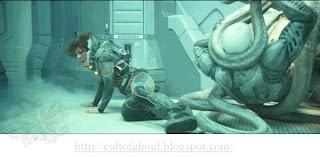Wallflower
(Short Cuts)
144 pages
I already gave a recommendation for
this book in the June issue of RUE
MORGUE, but I think it deserves a more detailed review, so here's a longer,
cyber-version.
FILM VIOLENCE is another in a long line of concise &
condensed studies, or at least clever overviews, of significant film topics,
themes and (sub)genres coming from Wallflower. It is number 45 in their ever-growing
Short Cuts series. I've already covered some previous titles here, like FILM
GENRE: From Iconography to Ideology by Barry Keith Grant.
The
book is divided into four chapters. Part one deals with "What do we mean
by 'film violence'?" and maps the complexity of the problem. First and
foremost, Mr. Kendrick presents the topic as crucial to understanding cinema
itself, since violence in all its guises is inherent to the flickering, "moving"
image (violence on the technological level: light piercing the eyeball and
deluding the brain with a deception of life). More obviously, it is linked to
the necessity for drama and conflict in what is basically narrative art. Furthermore,
"understanding film violence is central to understanding the social and
historical role of the cinema" (p. 4).
The author endeavors (and succeeds)
in his attempt to provide a general foundation for understanding film violence
from historical, ideological and generic perspectives, which entails looking at
how film violence has affected and been affected by governmental policies,
box-office receipts, gender difference, shifting notions of genre, well-known
auteurs, changes in narrative and broad social trends. Violence,
for Mr. Kendrick, is a "complex signifier" and he consistently
refuses monolithic definitions, preferring its presentation as a complex mode
of signification that needs to be thoroughly grounded in historical, cultural
and industrial contexts as well as subjective experience.
Chapter
two traces the depiction of film violence from the silent era until the present
day, focusing on aesthetic innovations (special effects, slow motion etc) and
various social responses to it. As the author puts it, "people have been
shooting and stabbing and slaughtering each other onscreen since the movies
began, and the only difference between then and now is that filmmakers have
adopted and made conventional increasingly graphic means of depicting these
violent behaviors" (p. 14). The crucial shift comes in the 1960s, when
explicit cinematic violence ventured from the disreputable grindhouse B-movies
into the respectable mainstream – first in Europe and Japan (esp. samurai
films), then in the USA, too (largely thanks to Hitchcock's PSYCHO and BIRDS).
Chapter
three focuses on how violence was used in several of Hollywood's most popular
genres (western, horror and action). Representation of violence in these genres
is connected to their ideological functions and their changes over time. Horror
is dealt with in about 10 pages, with special stress put on concepts of taboo,
monstrosity and transgression (thematic, ideological and visual).
Mr. Kendrick's brief analysis of
Paul Morrissey's Flesh for Frankenstein (1973) is rather unconvincing and
problematic: this film is labeled "reactionary" because it offers
"a sharp critique of excess in any form, particularly meaningless sexual
excess" (p. 87). So it would seem, according to Mr. Kendrick, that
"meaningless sexual excess" should, actually, be presented as progressive?
Morrissey's film is called "conservative" because of its ironic
stance towards the sexual revolution of its time. This is reminiscent of Robin
Wood's famous misunderstanding of Cronenberg's early horror films, criticized
for being against the "liberal" party line according to which
meaningless sexual excess was progressive and deserved all the praise. This is
surprisingly narrow-minded in an otherwise quite decent overview of the role of
violence in horror film and various theoretical approaches attendant to it.
Finally,
chapter four offers a case study of the central role of violence in the films
of directors of the New American Cinema in the 1970s, also known as The
Film-School Generation (F. F. Coppola, Martin Scorcese, Paul Schrader, Brian de
Palma...) and shows how they have reworked classical representations of
violence to distinguish themselves from the previous generations of filmmakers.
With this chapter the book ends somewhat abruptly, without conclusion of any
kind. Instead, there are helpful items like selected Filmography, Bibliography
and Index.
FILM VIOLENCE: History, Ideology, Genre is a scholarly text, but it is clear and
highly readable for those who are not film students. Its arguments are well
supported with a wide selection of quotes from relevant studies on the subject
so that it provides a rich overview of the variety of implications that film
violence can have. As such, it is vastly informative and educational,
insightful and revelatory to all readers interested in one of the essential
cinematic traits, fundamental for understanding cinema itself.





















